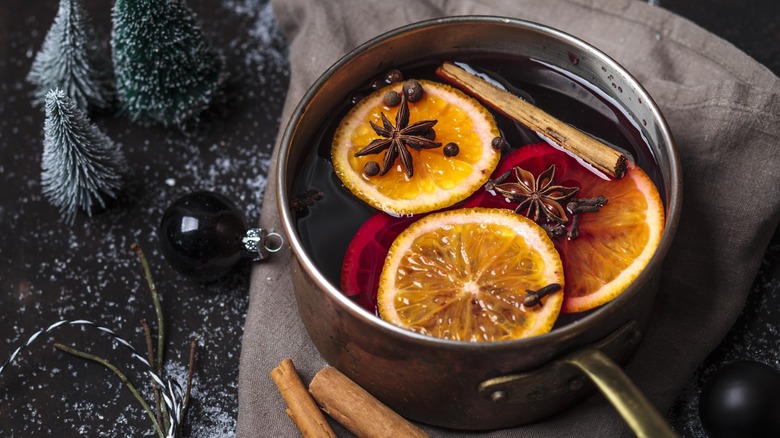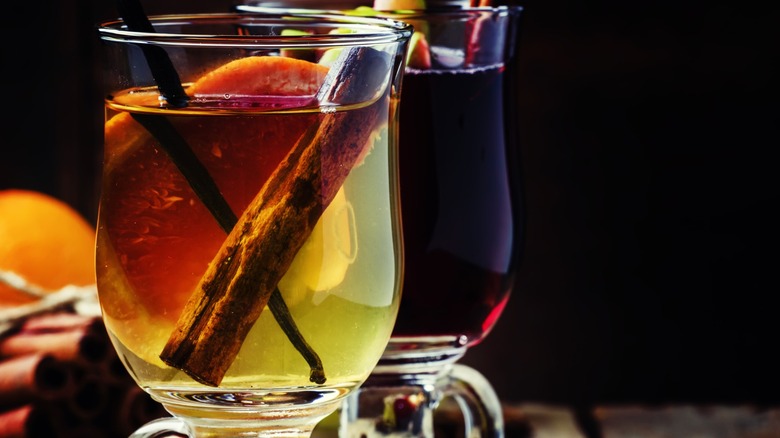The Absolute Best Types Of Wine To Use For Mulled Wine
When the snow's falling and the Christmas tree is up, 'tis the season for hot booze. Of course, one of the best drinks to ward off the winter chill has to be mulled wine. Just one sip of this sweet and spicy festive drink will transport you to a bustling, dreamy Christmas market somewhere in Europe. This beloved drink has a very long history, dating all the way back to ancient Rome, when wine was heated with sweet dates and spices like pepper, bay leaf, and saffron.
The mulled wine which most of us are familiar with today is made up of red wine simmered with spices such as star anise, cinnamon sticks, and cloves while being sweetened with maple syrup or honey. Sometimes a few slices of orange are added for fruity aromatics. Even outside the holiday season, mulled wine is always a fantastic way to breathe new life into half-finished bottles of wine.
If you don't happen to have leftover wine in the house, then it's worth getting a bottle specifically for mulling. It doesn't need to be an expensive one at all (in fact, it would likely be a mistake to get an expensive wine for the job since you'll be altering the flavor so much). Just keep a few tips in mind when choosing from aisles of different options. The key is to choose wines with low tannins and minimal oak, as these often develop bitterness when warmed up.
These red wines are wonderful for mulling
Light to medium-bodied dry and semi-dry red wines that are fruit-forward like Pinot Noir, Barbera, or Gamay (one of the writer's favorites for mulled wine!) are just perfect for mulled wine. With plenty of fruit notes like cherries and berries along with floral undertones and low tannins, the vibrant and juicy Gamay perfectly matches the fruity spiciness of the mulled wine. Barbera is also abundant in fruity notes and its earthy, peppery tones will add a rounded, soft, spicy kick to your mulled wine.
Merlot, Tempranillo, and Grenache stand out, too Slightly fuller-bodied, with more weight than those mentioned above, these wines burst with fruity notes with added layers of complex rich earthy, savory tones that can contribute to the depth of your mulled wine. The warm leather, smokiness, pepper, and vanilla notes in well-balanced Tempranillo and Grenache bring further coziness, while the chocolate and bay leaf hints in Merlot echo so wonderfully with the spices in mulled wine.
When making mulled wine, keep it from boiling to prevent alcohol loss and increased bitterness, especially in wines with higher tannins. To avoid overheating, you can set it to the lowest heat on your stove once the wine reaches about 163 degrees Fahrenheit, or you can remove the pot from the heat source and let it simmer for about 30 minutes to allow the flavors to infuse fully into the wine. Another easy-breezy way is that you can simply let a slow cooker do the work for you!
Making a mulled white wine
Besides red wine, you can also make mulled wine using a number of white wine varieties. Actually, white wine is ideal for mulled wine because they have fewer tannins – sometimes no tannins at all. Also, for aesthetic reasons, it's just picture perfect when you want to capture all the spices and fruits floating in your mulled wine. Honestly, you can't really go wrong with choosing a white wine, just steer away from sparkling wines, as you don't want those pretty, delightful bubbles to get lost in the simmering. Also, better avoid that heavily oaked Chardonnay for the same reason you want to avoid oaky reds. Fruity and crisp whites like Pinot Grigio and Chenin Blanc work wonderfully for mulling.
At the end of the day, there is no perfect formula for making mulled wine, and preferences about the spice and fruit choices vary anywhere from adding more nutmeg or cardamom to incorporating cherries, pears, or apple slices — it's all up to you! Just be very careful not to add too much of everything at once to give you more leeway for adjusting. And if booze is just not your thing? You can still have a toast with a cozy non-alcoholic mulled wine.


